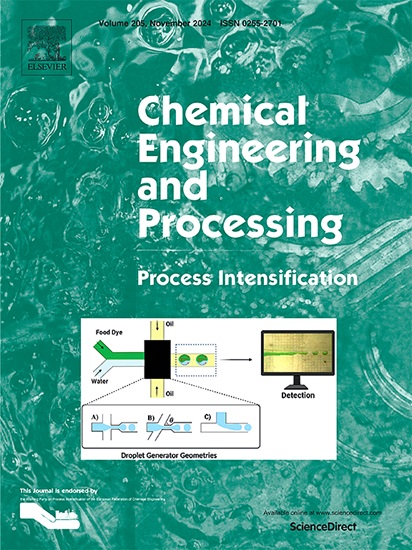Hydrogenation of vanillin to vanillyl alcohol over Pd/PDA/Ni foam in micropacked bed reactors
IF 3.8
3区 工程技术
Q3 ENERGY & FUELS
Chemical Engineering and Processing - Process Intensification
Pub Date : 2025-03-07
DOI:10.1016/j.cep.2025.110262
引用次数: 0
Abstract
The micropacked bed reactor (μPBR) with monolithic catalyst hydrogenation technology has received widespread attention due to its high efficiency, continuous operation, and safety. In this study, the Pd/PDA/foam catalyst was prepared via impregnation method and vanillin (VL) hydrogenation was investigated in green water solution based on the μPBRs. The effect of operating temperature, pressure, the number of foam catalyst block, VL concentration, liquid and H2 flow rate on VL conversion and VA yield was discussed. The highest conversion of VL was 99.4 % and product yield of vanillyl alcohol (VA) reached 84.9 % with 2.8 MPa, 120 °C, 22 blocks of Pd/PDA/Ni foam catalyst, H2 flow rate of 10 mL min−1 and liquid flow rate of 0.1 mL min−1, and short reaction time (0.106 h) in μPBRs. The kinetic of hydrogenation VL to VA was established. The reaction rate constant and activation energy in μPBRs were from 0.63 to 1.39 min−1 and 16.94 kJ·mol−1. The STY of VA in μPBRs was 0.0824 kg·L−1·h−1·g−1, which was bigger than that of batch hydrogenation devices.

求助全文
约1分钟内获得全文
求助全文
来源期刊
CiteScore
7.80
自引率
9.30%
发文量
408
审稿时长
49 days
期刊介绍:
Chemical Engineering and Processing: Process Intensification is intended for practicing researchers in industry and academia, working in the field of Process Engineering and related to the subject of Process Intensification.Articles published in the Journal demonstrate how novel discoveries, developments and theories in the field of Process Engineering and in particular Process Intensification may be used for analysis and design of innovative equipment and processing methods with substantially improved sustainability, efficiency and environmental performance.

 求助内容:
求助内容: 应助结果提醒方式:
应助结果提醒方式:


